Today’s development and operations teams are intertwined like the strands of a rope. The two heavily depend on each other to form a stronger, more solid unit. Unlike traditional teams that worked in silos, today’s developers and operations’ workflows should work like a well-oiled machine.
Each component needs to work together to create an efficient system that is greater than the sum of its parts. This way, it can meet the demands of a rapidly evolving market, technological advancements, and more sophisticated security concerns.
In this post, you’ll find powerful DevOps statistics you must know now to stay ahead of the curve.
Top Picks: Powerful DevOps Stats You Should Know
- 86% of organizations see the value of DevOps as important to have (Harvard Business Review)
- The global DevOps market will surpass $25.5 billion in 2028 (Report Linker)
- 54% of the time, DevOps teams are responsible for observability, monitoring, and security (Logz)
- Only 3 in 10 organizations can tell where their cloud spend goes (CloudZero)
- Over 80% of organizations now practice DevOps, which will increase to 94% in the near future – as soon as the next year (Puppet)
- Public clouds are the dominant DevOps platform — hybrid cloud and multi-cloud strategies are rising too (HBR and Google Cloud)
- 85% of DevOps professionals say the’ll be implementing a shared services model soon (Logz)
- 75% of DevOps teams comprise of up to 12 people (DORA)
Here’s the full story.
What Is DevOps?
DevOps is a set of practices that combines software development (Dev) and IT operations (Ops). It focuses on automation, collaboration, and integration between software developers and IT operations, to enable faster, more efficient, and more reliable software releases.
Note that DevOps is more of a cultural shift than a specific software engineering methodology. This cultural shift emphasizes a coming together of developers and operations teams in the interest of continuous improvement across IT environments.
Breaking down silos between developers and operations is one of the key components of the DevOps approach to achieving that goal.
Better yet, a DevOps culture encourages an organization to proactively build dynamic, secure, and resilient IT systems to support growth at any scale.
The combined team uses a DevOps pipeline to design, build, test, deploy, and continually improve a software product. In this process, people, measurements, sharing, DevOps tools, and automation are brought together to deliver high-quality software that supports optimal customer experiences.
And, a lot has been happening in the DevOps world. So, to stay current with the industry, here are some mindblowing DevOps stats you should know.
DevOps Market Size: What Does DevOps Look Like Today?
DevOps tends to look a bit different in every organization, so measuring its size globally is often tough. Still, here are some recent stats on the size of the DevOps market, demonstrating its popularity and growing adoption.
1. The global DevOps market will hit $24.71 billion by 2027 (source: Research and Markets, 2022)
In its DevOps Global Market Report 2022, Researchandmarkets.com predicts the DevOps market size will balloon from $10.84 billion in 2023 to $24.71 billion in four years. That growth represents a CAGR of 22.9%.
2. DevOps will generate over $35 billion annually by 2030 (source: Credence Research)
According to Credence Research, the DevOps market will generate $35.1 billion in 2030 from $9.85 billion in 2022. This growth will come from a growth in the services and tools that support DevOps implementation in various companies.
DevOps Adoption Statistics
In this section, we’ll explore who is implementing DevOps across the globe.
3. 80% of organizations practice DevOps (source: Puppet)
Puppet’s State of DevOps report shows that 8 out of 10 organizations have DevOps implementation ongoing. However, 80% of respondents said they were somewhere in the middle of the implementation process. Others said they had languished at this point for some time, not sure how to proceed.
4. 77% of organizations currently depend on DevOps to deploy software — or plan to do so soon (source: HBR)
According to the Harvard Business Review Analytics Services survey, 563 of the 654 respondents considered it important to develop and release new software quickly.
Despite this, only 10% of respondents felt their company was successful at developing and deploying software quickly. And so, whoever fills this gap will have a competitive advantage.
5. 74% have adopted DevOps (source: RedGate)
RedGate surveyed over 3,200 enterprises for its State of DevOps report. The report showed showed that nearly three quarters of organizations, had adopted DevOps practices for development in some form (versus 47% five years ealier) and that using cross-platform databases had risen markedly.
It also noted the pandemic forced DevOps adoption, saying “IT thinking had moved further, faster, and more permanently than any previous year “.
6. 50% of DevOps adopters are elite or high performers (source: Nagarro)
The State of DevOps in 2022 report concluded that about half of organizations surveyed could be classified as elite or high performers. According to Nagarro, that was a 30% improvement from the results they got a year prior.
7. 15% are still planning while 9% are yet to adopt DevOps (source: Logz)
Nearly 4 out of 10 respondents to Log’s 2021 DevOps Pulse Survey said they had embraced DevOps practices in everything they were doing.
Another 38% said they had adopted DevOps partially. Only 15% and 9% acknowledged that they were still in the planning stages and had not yet begun, respectively.
What Do DevOps Teams Actually Do Or Where Do DevOps Engineers Work?
DevOps professionals work in six main roles, each of which corresponds to a phase in the DevOps pipeline:
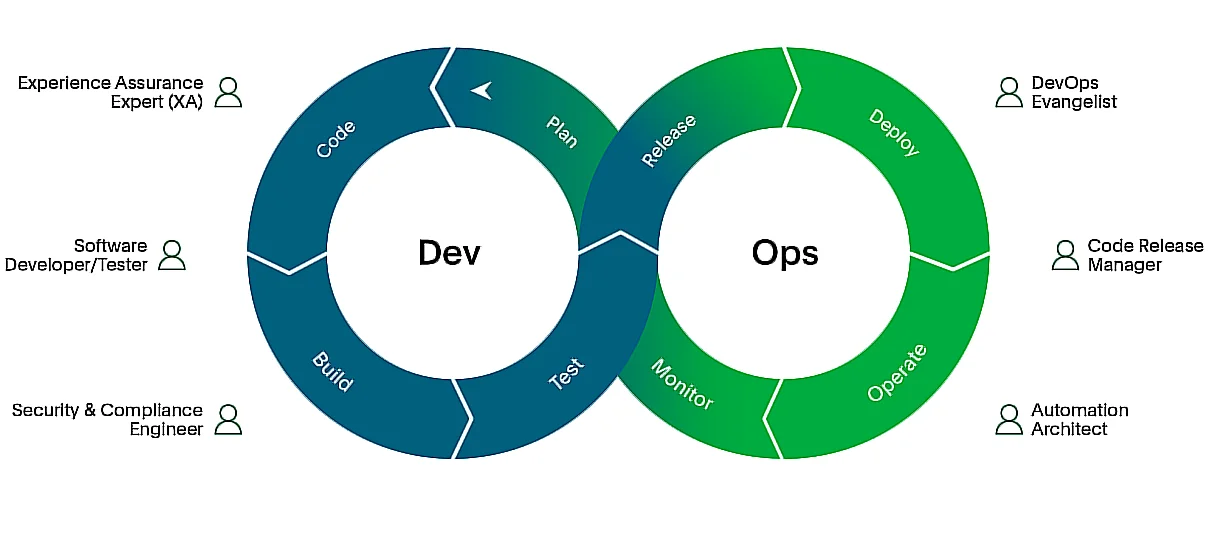
Credit: DevOps engineers roles – PagerDuty
Now, the following statistics can help show where DevOps fits in within an organization.
8. 63% of DevOps engineers work in five roles (source: GitLabs)
In its Global DevOps Survey for 2023, GitLab found that most DevOps engineers work in five roles; software engineer or developer, development/engineering manager/director, technology executive, DevOps manager or director, and DevOps engineer.
9. Most DevOps professionals practice as software engineers (source: GitLab)
Out of the 5,000 Dev, Ops, and security professionals GitLab surveyed, 950 (or 19%) worked as software engineers or developers, the most common DevOps role. Professionals with the role of “DevOps Engineer” made up 5% or 250 respondents. Likewise, Software Engineering was the most common functional area.
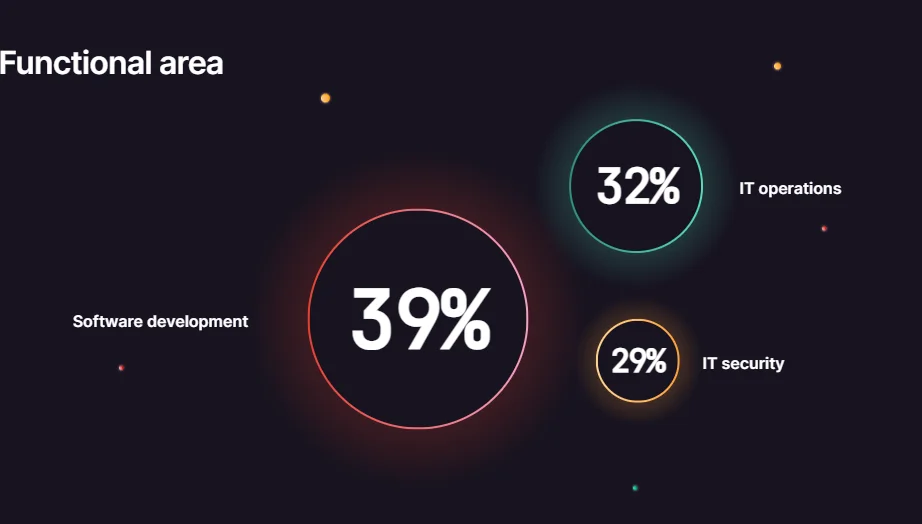
Credit: Global DevOps Survey 2023 – GitLab
However, DevOps engineers also work as quality assurance leads, FinOps engineers, MLOps professionals, consultants who offer DevOps-as-a-Service, site reliability engineering (SRE engineering) or working as a transitional DevOps unit between an organization’s Devs and Ops teams.
10. DevOps specialists work across departments and teams (source: DORA)
According to Google’s Accelerate 2022 DevOps Research and Assessment (DORA) survey, 26% of participants worked on development or in engineering teams, 23% as DevOps or in SRE teams, 19% were in IT Ops or as a part of infrastructure teams, and 17% as managers.
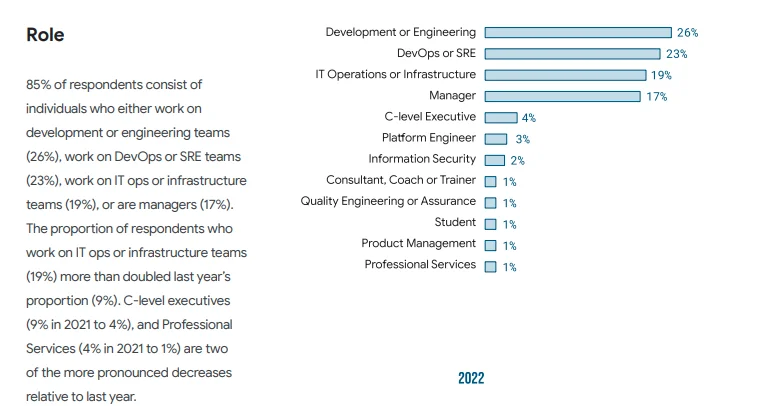
Credit: DevOps Specialists roles in 2022 – Accelerate DORA survey
According to the 2021 DORA survey, C-level executives increased to 9% in 2021 from 4% in 2019. But DevOps consultants reduced in 2021 to 2% from 4% in 2019.
What Industries Implement DevOps?
You are right if you believe technology companies are leading the way in DevOps adoption. However, other industries have also adopted DevOps practices for IT operations.
11. 39% of DevOps organizations are in the computers/software industry (source: GitLab)
GitLab’s survey found 1 out of 4 organizations that practice DevOps are in the computer hardware or software services (including SaaS) industry. Other industries made up around 5% of respondents.
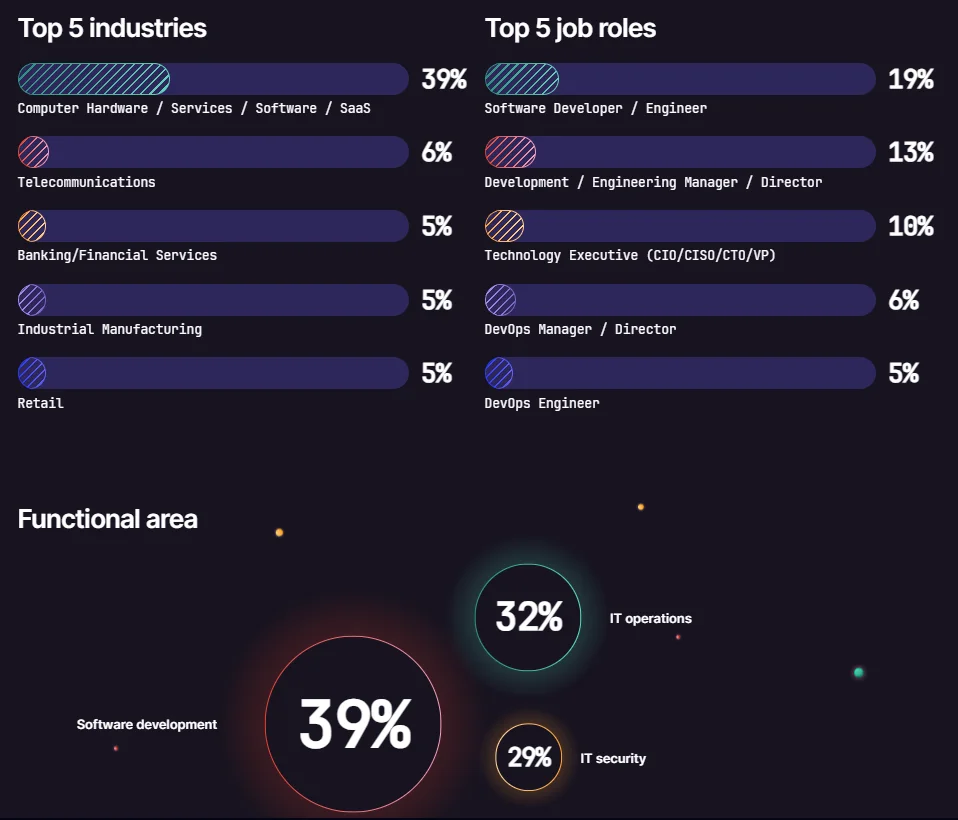
Credit: GitLab’s Global DevOps Survey 2023
12. DevOps implementation is quite popular across most industries (source: DORA)
DORA’s survey of over 33,000 professionals found 44 out of 100 respondents worked in the technology sector. Yet, non-profits, energy, and healthcare organizations also apply DevOps practices today.
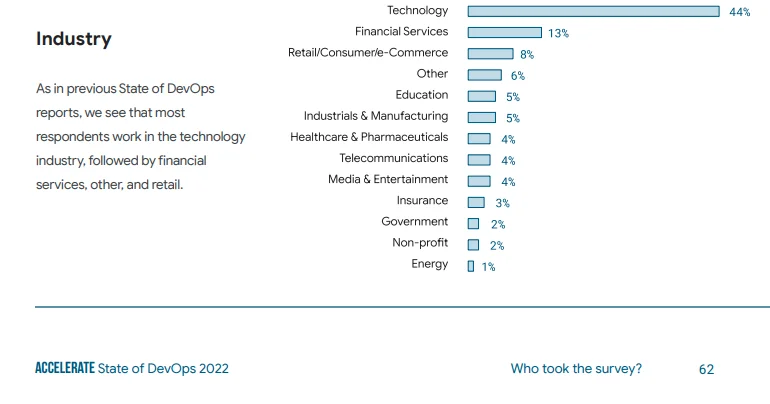
Credit: DORA 2022
13. Most DevOps engineers work in organizations that have 100 to 1,000 employees (source: DORA)
Half of the respondents in the 5,000-strong GitLab study said their organizations had between 101 and 999 employees. About 23% of all participants came from an organization with between 100 and 249 employees.
The larger 2022 Accelerate DORA survey confirms this, showing only 16% of all respondents worked in organizations with over 10,000 employees versus 17% in organizations with 100 to 500 employees.
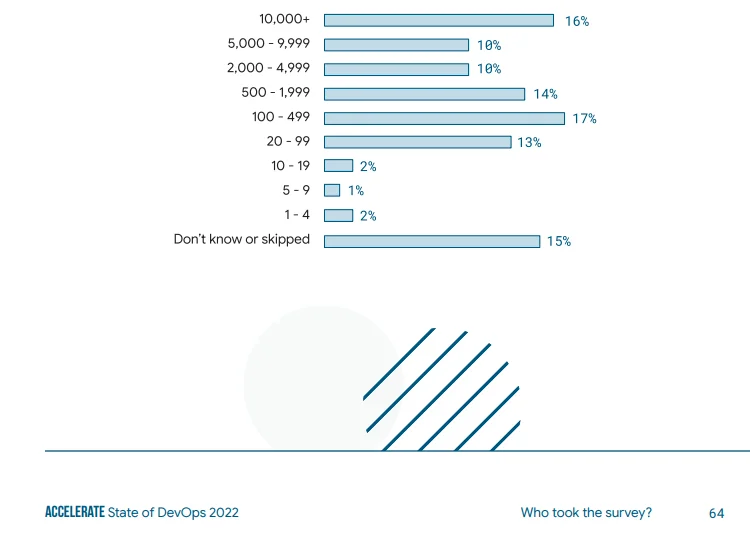
Credit: DORA’s State of DevOps 2022
Next, we’ll look at the demonstrated benefits of implementing DevOps today.
Stats On The Benefits Of DevOps
Implementing DevOps best practices can take a lot of time, talent, and financial resources. So, is it worth it? Or, what are the proven benefits of adopting DevOps?
14. 86% of professionals see the value of a DevOps culture (source: HBR and Google Cloud)
The Harvard Business Review Analytics Services survey found that 563 out of 654 respondents (86%) said developing and releasing software rapidly was important. And, 1 in 10 of these respondents said they felt their company is “very successful” at quickly developing and deploying software.
15. Implementing DevOps has multiple benefits (source: Puppet)
Puppet’s 2023 State of DevOps Report showed evolved DevOps teams saw benefits in terms of deployment frequency (deployed on-demand), minimum time to repair (took less than an hour MTTR), lead time for changes (took no more than an hour), and change failure rate (achieved less than 5%).
16. Elite DevOps teams take less than a day to restore failed services (source: DORA)
According to Google’s DORA research, the top DevOps performers restore service after an incident within a day, have less than 15% change failure rate, and deploy changes to their code multiple times a day instead of once every several days, weeks, or months.
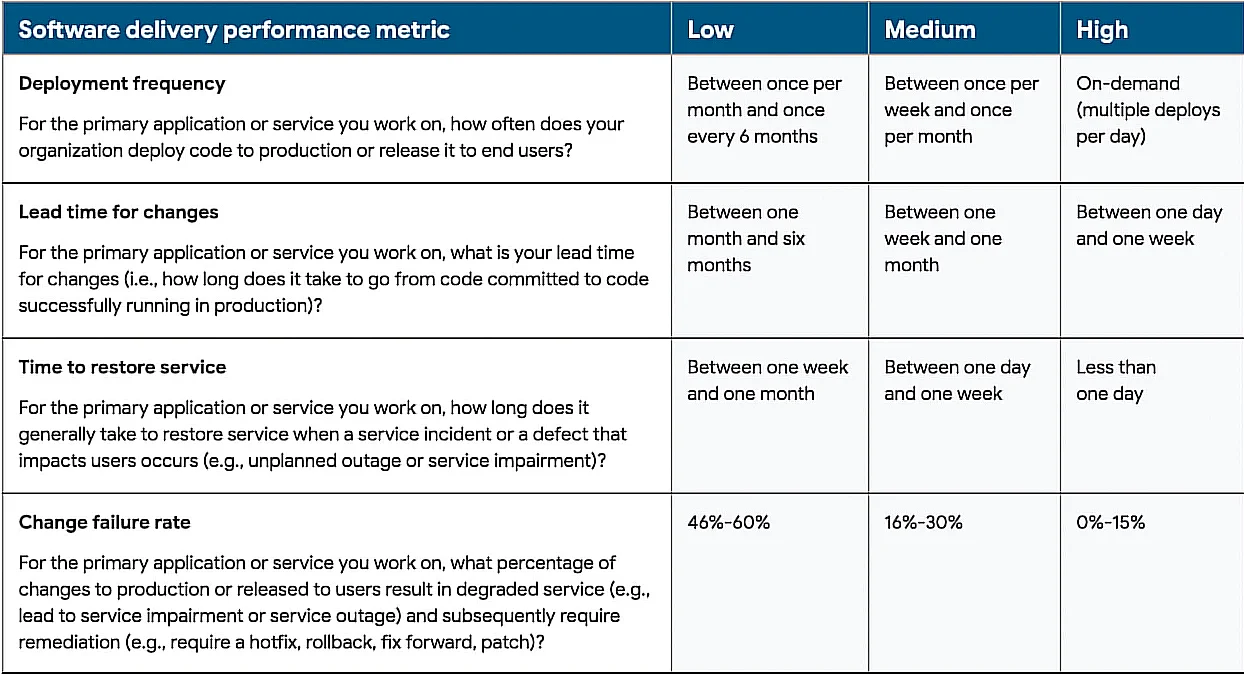
Credit: 2022 DORA
17. 17% of teams achieve a good balance in everyday operations (source: DORA)
The same survey findings show 17% of the respondents manage to balance high stability with high reliability and high throughput. About 23% are in the early stages of developing a feature, product, or service and hence are still collecting feedback as you can see under the “Starting Cluster”:
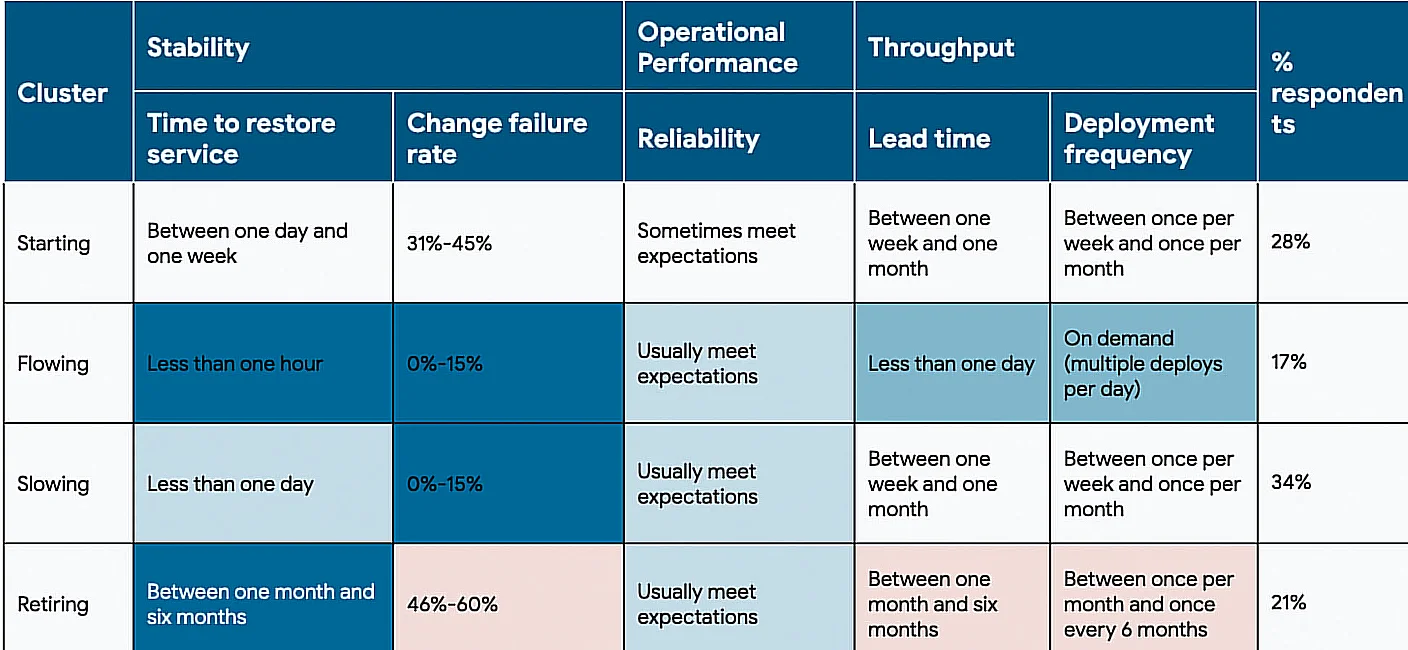
Credit: Accelerate 2022 survey by DORA
18. Elite DevOps teams see massive benefits (source: DORA)
In 2019, DORA reported “elite” teams were 2,064X faster to recover service from an incident than low performing groups.
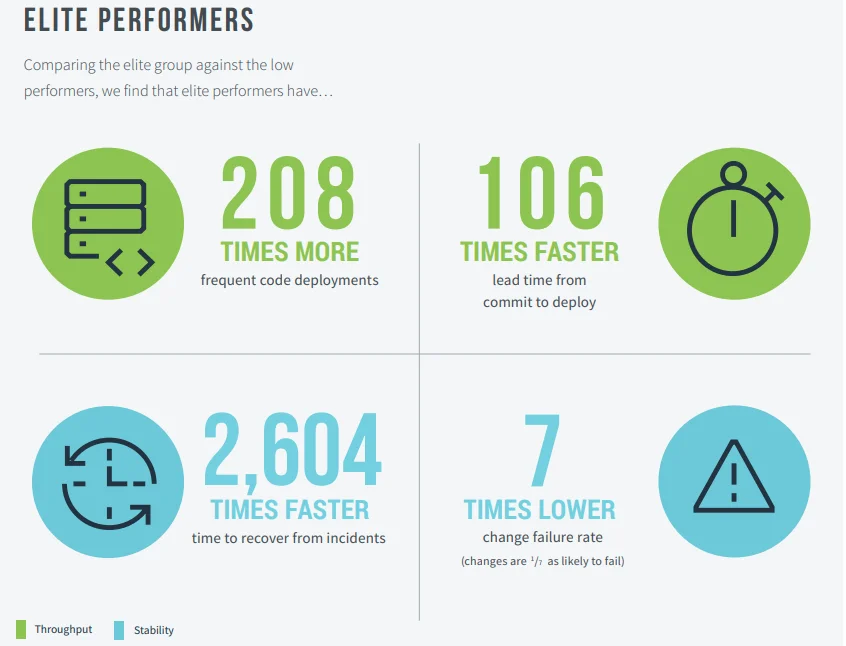
Credit: 2019 State of DevOPs – DORA
19. A DevSecOps approach promotes data security (source: IBM)
Organizations that are implementing DevSecOps best practices are seeing significant data and system security benefits. Companies that are yet to consider it risk incurring up to $4 million per data breach, according to IBM’s Data Security report.
20. DevOps provides a robust framework to deploy containers and microservices (source: Google Cloud)
Google Cloud’s DORA survey found 54% of engineers are using DevOps practices to deploy containerized applications. This makes sense, considering containers and microservices require a highly dynamic and efficiency-focussed engineering culture to deliver benefits without breaking the bank.
DevOps And Cloud Usage
One of the biggest aspects of adopting DevOps is to move workloads to the cloud to facilitate flexibility/elasticity in resource, costs, and continuous improvement (CI/CD) management. And many DevOps teams across the globe have made the digital transformation, according to these stats.
21. Cloud users are 14% more likely to succeed (source: DORA)
Respondents who used cloud computing were 14% more likely to hit and exceed their performance goals as an organization than non cloud users. Yet, the researchers found that cloud users of all types (public, private, hybrid, and multi-cloud) had a negative association with change failure rate, contributing to a higher change failure rate.
22. Public cloud deployments are most popular followed by hybrid cloud strategies (source: DORA)
DevOps teams that practice within the hybrid cloud model made up 42% of respondents. But public cloud users (or multiple public cloud users) made a staggering 76% of the participants. Teams that didn’t use the cloud reduce by half in 2022 versus the previous year.
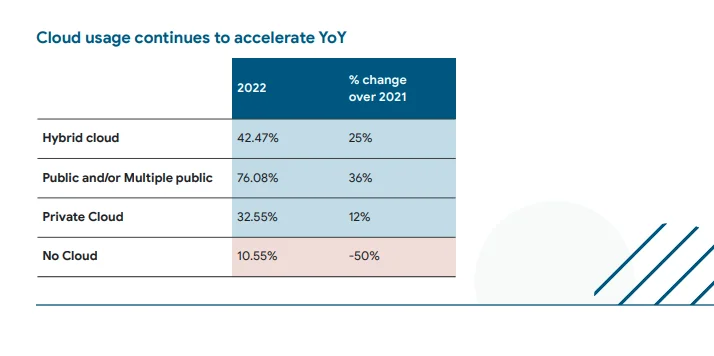
Credit: Most DevOps teams use public cloud deployments
23. 63% of DevOps teams use a hybrid cloud strategy to boost availability (source: DORA)
Although DORA found hybrid cloud and multi-cloud strategies negatively impacted software delivery performance, most organizations used them for strong reasons, most notably to increase availability.
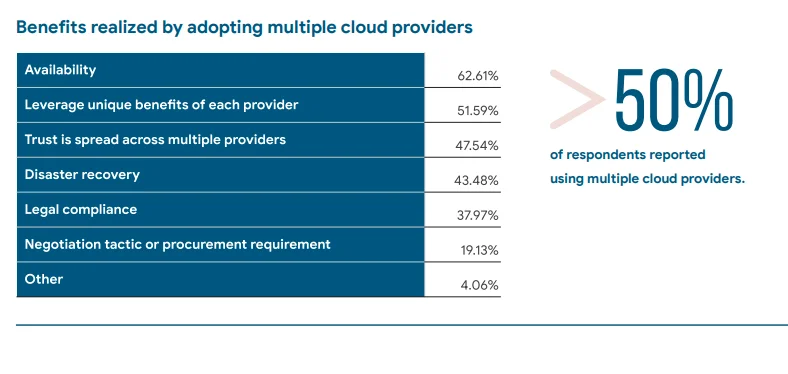
24. 30% of DevOps teams meet the five essential characteristics of cloud computing (source: DORA)
The findings show that out of the respondents who said they’d adopted cloud technologies, 30% are already achieving the holy grail parameters of cloud computing:
- On-demand self service (provisioning resources as and when needed and automatically)
- Rapid elasticity
- Resource pooling in a multi-tenant architecture
- Broad network access
- Measurements in usage
With more organizations moving to the cloud, their DevOps teams will want to learn more about CloudOps to maximize their return on cloud investment.
Statistics On DevOps Usage
25. High-achieving DevOps teams use CI/CD practices (source: DORA)
Top DevOps performers were 1.4X more likely to leverage Continuous Integration and Continuous Deployment/Delivery (CI/CD) practices to boost reliability.
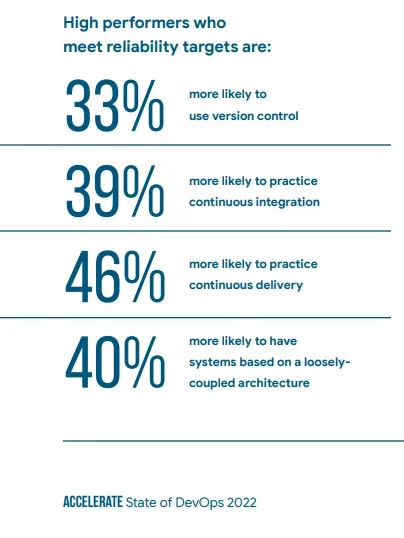
26. Version control and CD deliver 2.5X faster software deliveries (source: DORA)
Combining Continuous Delivery with Version Control led to faster software delivery than only focussing on one. Want to use the best? Check out our guide to the top CI/CD tools available today here.
27. The leading deployment target for DevOps teams is containers (source: DORA)
More than half of teams surveyed in DORA’s 2022 State of Devops survey said they used DevOps practices to deploy containers. That was a higher number than those who used DevOps for SaaS (47%), cloud-based virtual machines (42%), bare metal servers (31%), and even mobile devices (33%).
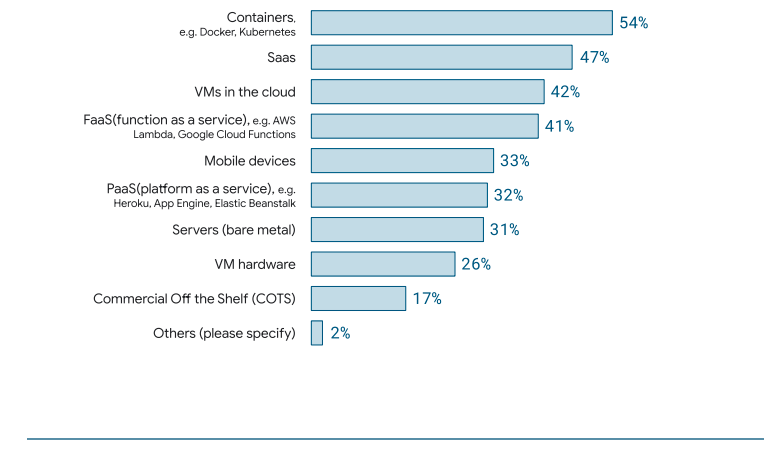
Credit: DORA State of DevOps for 2022
Statistics On The Top DevOps Tools And Automation
Automation is a key component of any DevOps implementation. Successful teams leverage automation to minimize manual processes and free up engineers’ time to focus on more value-added work.
28. DevOps teams use multiple tools at the same time
Most teams deploy a number of DevOps tools because each stage of the DevOps lifecycle requires a different tool, best practices, and workflows. We’ve compiled a handy guide to the top 55 DevOps tools here that successful teams use today.
29. 25% of teams integrate DevOps tools into one platform to reduce complexity (source: Transposit)
Using multiple tools separately increases complexity and blindspots. Others were at different levels of integrating their tools.
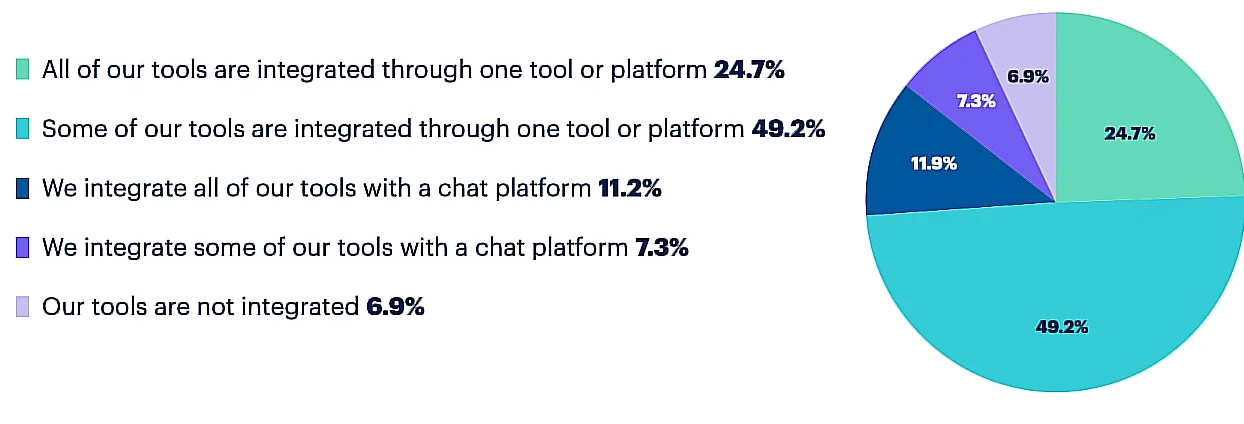
Credit: State of DevOps Automation 2022 Report
30. 81% plan to expand their automation efforts (source: Stonebranch)
In an effort to improve their automation today, most companies want to grow their automation initiatives, according to the 2023 Global State of Automation Report. A staggering 86% of respondents said they would add a new automation platform or replace an existing one.
31. 26% of organizations with over 300 employees have two or more engineers dedicated to automation (source: Transposit)
Another 39% of respondents in the same State of DevOps Automation 2022 Report said they had a full-time DevOps professional to help them automate DevOps workflows. There’s more:
- Automation is hindered by three main barriers: inadequate documentation (56.4%), uncertainty about what needs to be automated (55%), and inadequate knowledge sharing (51.8%)
- 80.4% of participants agreed automation should facilitate human technicians to use their judgment primarily at critical decision points.
The respondents also acknowledged that capturing and using data around human actions and decisions is currently a struggle.
What Is The Best Platform For What, According To DevOps Engineers?
We already noted earlier that most highly evolved DevOps organizations use the public cloud for their workloads. But, which Cloud Service Providers (CSP) do they work with?
32. AWS, Azure, and GCP are the most popular cloud platforms today (source: Flexera)
Amazon Web Services has been the preferred CSP for most since 2006 – and it still holds the largest market share (33% vs Azure’s 23% and GCP’s 11%). But Microsoft’s Azure Cloud has gained ground over the years, including surpassing AWS in some areas, according to Flexera.
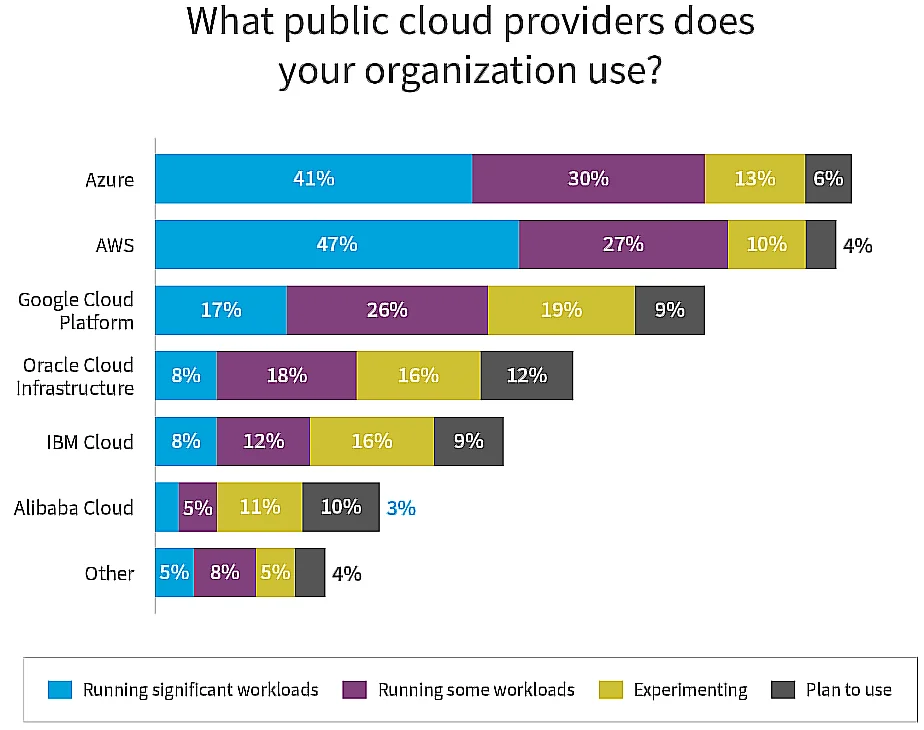
Credit: Flexera’s State of the Cloud Report for 2023
33. SMBs prefer AWS over Azure (source: Flexera)
While small and medium businesses prefer AWS for its pricing and service options, larger enterprises prefer Azure, likely because they already extensively use Microsoft products such as Microsoft 365 and Azure Virtual Desktop.
Learn more about AWS vs Azure vs Google Cloud platforms here. Better yet, check out our no-bs guide to Azure vs AWS pricing here.
34. 93% of teams say adopting platform engineering is the right direction (source: Perforce)
Almost everyone agrees that platform engineering helps design, build, and develop self-service capabilities that minimize cognitive load on developers. It also promotes faster software deliveries, according to the 2023 State of DevOps Report by Perforce’s Puppet.
DevOps Team Management Stats
Here are some insights into what DevOps teams look like and how they work today.
35. 75% of teams are up to 12 people (source: DORA 2022)
Only 25% of respondents in said they worked in teams with fewer than five people. Half of participants said their teams had eight or fewer people. Meanwhile, the vast majority said they worked as groups of up to 12 people or fewer.
36. Most DevOps engineers have 6-10 years experience (source: DORA)
Thirty-one percent of respondents in the 2022 survey said they had 6-10 years of experience compared to 20% in 2021. Surprisingly, the 2021 edition had found 41% of participants had over 16 years of experience compared to just 13% in 2022. This may explain why 2021 findings had more tech executives, consultants, and other leaders than in the 2022 survey.
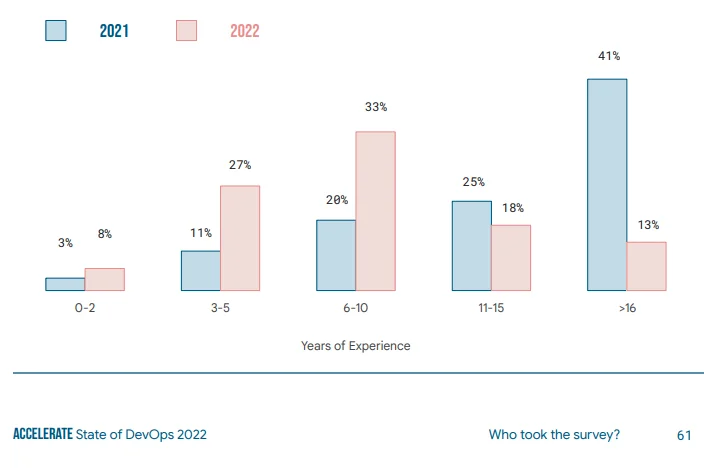
Credit: How experienced are DevOps professionals in 2023?
37. 57% of DevOps professionals agree that IT framework and process skills are the most important (source: Perforce)
A lack of adequate skills is the biggest challenge for most teams today. And, according to the Puppet by Perforce survey, the most important skills are security/DevSecOps, cloud platforms, container orchestration, architecture, and application technologies — in that order.
DevOps Observability And Monitoring Statistics
The DevOps approach thrives on the back of continuous observability, monitoring, and measurements. This is how DevOps teams get to detect, track, and act on warning signs before they become major problems or outages. Here are interesting insights you’ll want to know about it.
38. Modern technologies can reduce observability (source: Logz)
Logz’s last three DevOps Pulse reports have shown that strategies such as Hybrid cloud and multi-cloud deployments as well as platforms like Kubernetes and microservices tend to hinder observability for about half of all respondents.
Most DevOps teams (85%) are also relying on multiple tools for observability, increasing complexity. Overall, these issues caused teams’ minimum time to resolve (MTTR) increase — only 14% are satisfied with their MTTR in 2023.
39. Most organizations perform observability with the aim of increasing visibility into costs (source: Logz)
Nearly 36% of respondents told the DevOps Pulse researchers that they were looking to observability and monitoring to better understand costs, to adapt data management practices (27%), and to adopt open-source frameworks (26%) to prevent vendor lock-in.
The 2022 survey, which is the larger of the bunch, with over 1,000 participants, also showed:
- 54% of respondents say DevOps professionals are charged with the responsibility of observability and continuous monitoring
- 73% take several hours to resolve production issues
- Grafana, Prometheus, and AWS CloudWatch are the most dominant observability and monitoring tools today
Also, over 85% of participants are exploring working with a shared services model for various reasons:
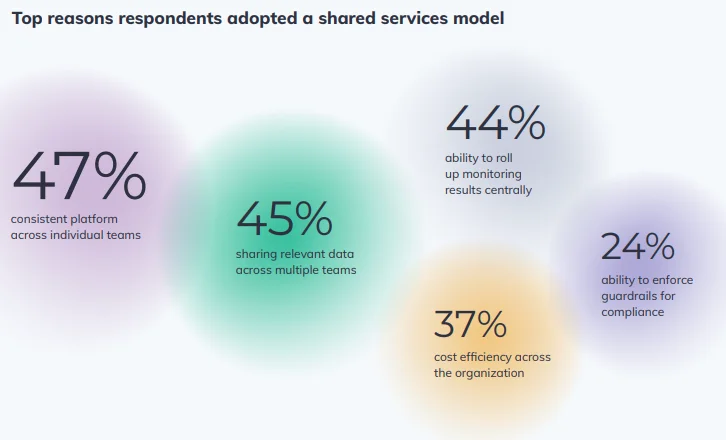
Credit: Why DevOps teams want a shared services model although it can make observability a little more complicated
And speaking of complications, here are some of the challenges in DevOps today.
DevOps Challenges
From a growing skills gaps to system monitoring challenges to tools sprawl, DevOps has its fare share of challenges to beat.
40. Skills shortage is the leading DevOps challenge today (source: Puppet)
Puppet’s survey respondents said their main challenges included, in order:
- Skills shortage (33%)
- Legacy architecture (29%)
- Organizational resistance to change (21%)
- Limited or a lack of automation (19%).
Contrary to this, highly evolved teams seem to face more fundamental challenges, such as skills shortage (29%) and legacy architecture. Cultural challenges are no longer an issue for the well-developed teams.
41. Out of 367 IT and business leaders, 113 say people issues are a major concern (source: Gartner)
In fact, 31% of respondents said this was the primary concern, ahead of process, technology and IT issues which they said were lesser issues to manage.
42. Half of DevOps teams struggle to collaborate (source: Transposit)
Teams seem to be struggling to communicate and collaborate efficiently, taking 15-30 minutes for the right people to come together to solve an issue. Complexity is a major contributing factor as well:
- 52.9% struggle with reaching the right team members with specialized knowledge
- 49.3% are dealing with too many manual processes
- 52.3% said their MTTR increased over the course of the last year.
The top challenge reported by 45.2% those who saw their MTTR increase was lacking ununified communication (working with disparate tools).
The survey also found:
- 58.2% of respondents said that downtime costs their organization an average of up to $499,999 per hour
- 39.7% of respondents said they noticed the cost of downtime increased over the past year.
DevSecOps Statistics
The practice of DevSecOps combines best practices from Dev and Ops with continuous security practices. Currently, DevSecOps is a huge trend that will continue to receive lots of attention in the future. Here’s what that means.
43. 72% of respondents said they are unifying security and observability/monitoring (source: DevOps Pulse 2023)
To keep tabs with the dynamic nature of security threats and other risks, DevOps professionals said they were already or planning to employ an integrated model for security and observability.
44. 70% of organizations are yet to actually implement DevSecOps (source: Cloud Security Alliance)
Here’s the thing. Over 90% of organizations said they are working toward DevSecOps. But only one in three were implementing DevSecOps in 2021. Some 24% were in the planning phase in 2021/2022, 18% were designing, while 18% were still fine-tuning their DevSecOps strategy.
However 42% said they would adopt full DevSecOps within a year. Surprisingly, about 10% of surveyed security professionals said they had no plans to involve themselves in DevSecOps at all.
45. Misconfigurations were largely attributed to inadequate or flawed internal guidance (source: Cloud Security Alliance)
According to the Secure DevOps and Misconfigurations report, just over 3 in 10 professionals said there wasn’t enough training, internal knowledge or support around misconfigurations and vulnerabilities. Insecure default settings (at 18%) and negligence (at 16%) also contribute to misconfigurations.
46. DevSecOps tooling is diverse to curb diverse risks (source: Logz)
Respondents reported applying a variety of dedicated security solutions including:
- Web application firewalls (39%)
- Firewalls/Intrusion Prevention Systems (22%)
- Security Information Event Management (SIEM) systems (19%)
Ransomware (46%), DDoS (41%), insider threats (39%), and access misconfiguration (39%), among others, were the most common threats.
Women And The Under-represented In DevOps Statistics
The latest DORA research had interesting findings over the previous year’s survey.
47. 19% of team members come from the under-represented (source: DORA)
About two in ten respondents said they belong to an under-represented group, based on race, gender, or another characteristics. For example, 11% of DevOps team members reported being disabled.
48. Women make up 25% of DevOps teams (source: DORA)
In 2022, 18% of respondents identified as female and 76% as male. Combined, both said their DevOps teams had at least one woman for every four team members.
Cloud Cost Management For DevOps
DevOps teams are concerned about keeping their Total Cost of Ownership (TCO) reasonable. Here’s what that looks like:
49. Only 30% of companies know how their cloud budget is spent (source: CloudZero)
The 2022 State Of Cloud Cost Intelligence Report shows that seven out of ten organizations do not know where their cloud budget goes — a frightening picture of cloud cost attribution. This leads huge cloud cost optimization challenges and cloud waste (up to 32% of cloud spend).
50. Managing costs is the biggest concern for all organizations (source: Flexera)
Managing cloud spend, in particular is the number one concern for SMBs and enterprises — and has been for the last five years in a row. This situation is so concerning that it outweighs security concerns and skills shortages for most respondents.
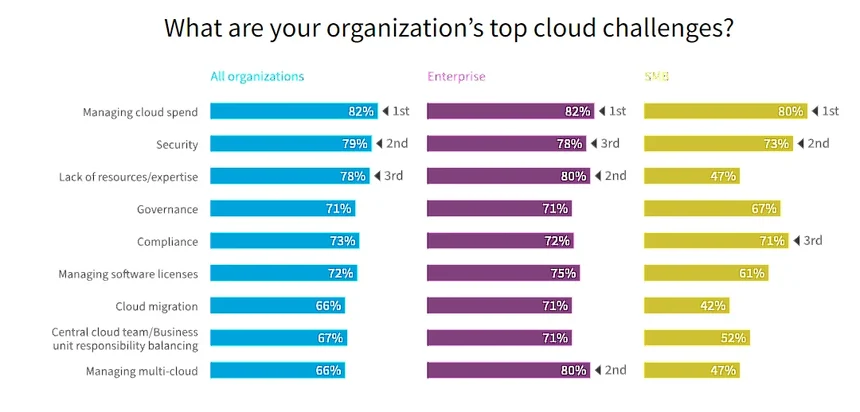
51. 78% noticed cloud cost variance when its too late (source: CloudZero)
A mere 22% of respondents said they detected cloud cost anomalies instantly or within minutes. In particular, about 8% of respondents noticed cost anomalies after a week or longer, 14% after days, and 56% within hours.
Also, it didn’t help that many teams still use multiple cloud cost management tools for cost observability, and this lead to blindspots, complexity, and hindered analyses.
DevOps Trends Statistics
So, what are the top DevOps initiatives right now? The latest survey results by the DevOps Institute highlight what’s happening in DevOps and what to expect in the foreseeable future.
52. DevSecOps is a leading initiative among DevOps teams across all organizations (source: DevOps Institute)
DevSecOps (security and compliance) is a hot topic. In 2023, security is a high-priority consideration alongside cost management, system reliability, and improving MTTR. DevSecOps scored 56% in the automation tool category according to participants in the Upskilling IT report.
53. 44% of IT leaders are at advanced stages of promoting upskilling for their DevOps professionals (source: DevOps Institute)
The DevOps Institute reports that more IT leaders are implementing upskilling programs to foster the right talent and skills for their needs:
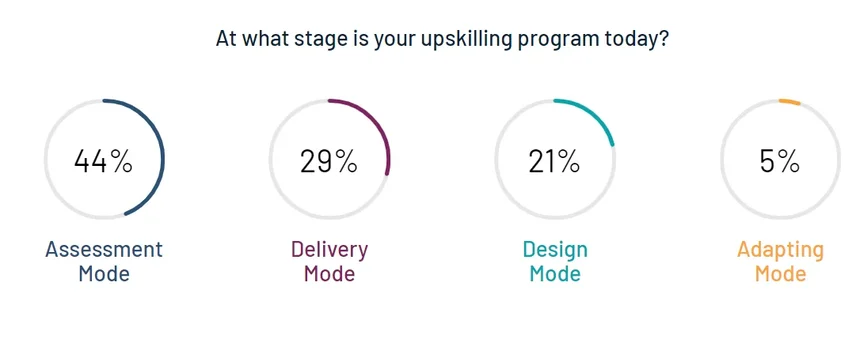
Credit: Upskilling IT 2023 report – DevOps Institute
54. The rise of DataOps and ModelOps (source: DevOps Institute)
As technology stacks and amounts of data ingested increase, newer DevOps models are showing up. A few examples of burgeoning technologies for DevOps implementation include Artificial Intelligence, Machine Learning, Serverless, Chaos engineering, Containers, DataOps, ModelOps, and Microservices. For example, DataOps scored a 27% as a must-have skill for automating DevOps workflows while ModelOps got 22%.
55. Nearly 76% of respondents are incorporating more SRE practices (source: Transposit)
As more DevOps teams look to boost reliability and continuous improvement, they are leveraging more Site Reliability Engineering best practices -– and seeing significant benefits to their company’s bottom line as a result, according to Transposit’s State of DevOps Automation report.
DevOps Growth Forecast
According to Research Linker, the DevOps market size will surpass $25.5 billion by 2028, a 19.7% compound annual growth rate (CAGR).
Global Industry Analysts Inc projects a global DevOps market value of $17.6 billion by 2026, based on its 2021 market study.
Still, Gartner warned that trying to scale DevOps initiatives too much and too quickly could lead to counterproductive results.
What’s Next: View, Understand, And Control Your DevOps Costs The Easier Way
In highly evolved IT teams, cost has become a first-class metric. Whether it’s from unplanned activity or cost spikes from surprise billing, keeping cloud costs under control is a key DevOps initiative this year.
Yet, too many DevOps teams still use multiple cloud cost management tools. These tools are unintegrated, clunky, inexact, and manual. The result: sleepless nights, inefficient cost allocation, way too much coffee, and dwindling donut budgets.
With CloudZero, this doesn’t have to be your problem. Instead, you can enjoy:
- Capture, understand, and base your decisions on immediately actionable unit cost insights. Think: cost per customer, per DevOps team, per environment, per deployment, per product, per feature, and more.
- Use true cloud cost intelligence across AWS, Azure, and GCP within a single platform. CloudZero also covers Kubernetes, Snowflake, Datadog, MongoDB, and more.
- No manual cost allocation tags required here. No endless tagging either.
- View the costs of tagged, untagged, and untaggable resources to get the complete picture and prevent cost surprises
- Reliably see the costs of specific tenants in multi-tenant environments (shared services model)
- Accurately allocate 100% of your cloud spend
- Take advantage of real-time cost anomaly detection and receive timely, noise-free alerts via Slack, email, etc
- Get more without the overwhelm, including budgeting and forecasting tools.
With CloudZero, Drift is saving $2.4 million annually on AWS costs. Both MalwareBytes and Remitly have improved how they allocate costs. That’s because CloudZero reveals to them exactly who, what, and why their costs are changing, instead of guessing.
Want this level of cloud cost visibility?  to get started. Our FinOps Account Management team will show you around.
to get started. Our FinOps Account Management team will show you around.








